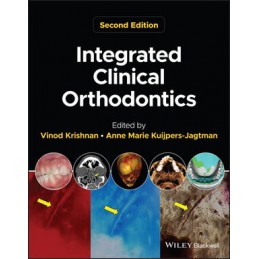- Reduced price

Order to parcel locker

easy pay


 Delivery policy
Delivery policy
Choose Paczkomat Inpost, Orlen Paczka, DHL, DPD or Poczta Polska. Click for more details
 Security policy
Security policy
Pay with a quick bank transfer, payment card or cash on delivery. Click for more details
 Return policy
Return policy
If you are a consumer, you can return the goods within 14 days. Click for more details
Integrates orthodontic diagnosis and treatment into the wider healthcare of the patient to achieve the highest possible standards of care
Integrated Clinical Orthodontics offers an overview of clinical orthodontic theory and practice to equip clinicians to take an integrated approach to orthodontic practice. It presents the problems of orthodontics in an interdisciplinary context to describe how the potential complexity of dentofacial problems, the medical histories of patients, and a host of other factors contribute to orthodontic outcomes. The second edition has been expanded and thoroughly updated with new chapters and following an organized approach to the role of the orthodontist as part of a team. Cases in the book include orofacial deformities, sleep disorders, esthetic smile creation and temporomandibular joint problems.
Orthodontic diagnosis and treatment are integrated into the wider health of the patient, including orthopedics, neurology, pediatrics, genetics and psychology, and the result is a modern, adaptable approach that places the patient and their needs at its center to achieve the highest possible standard of patient care.
Readers of the second edition of Integrated Clinical Orthodontics will also find::
Integrated Clinical Orthodontics is an essential resource for clinical orthodontists and specialists in related medical and dental fields who wish to take the holistic view of orthodontic practice.
Data sheet
List of Contributors xiii
Preface to Second Edition xvii
Preface to First Edition xviii
Part I Diagnosis, Psychology, and Genetics 1
Chapter 1 The Increased Stature of Orthodontics 3
Vinod Krishnan, Ze’ev Davidovitch, and Anne Marie Kuijpers-Jagtman
The broadening scope of orthodontics 6
The orthodontic patient as a human being 7
The patient’s biological status: does it influence orthodontic treatment? 8
Conclusions 16
References 17
Chapter 2 Orthodontic Diagnosis and Treatment Planning: Collaborating with Medical and Other Dental Specialists 18
Om P. Kharbanda, Neeraj Wadhawan, and Karthik Sennimalai
The other side of the story 19
Orthodontic diagnosis from a broad perspective 19
The first interaction with the patient 19
The importance of the medical history in orthodontic diagnosis and treatment planning 21
Overview of systemic disturbances in relation to orthodontic treatment planning 27
Identifying local dental abnormalities before attempting orthodontic treatment 32
Evaluation of the occlusion and the temporomandibular joint 42
Radiographic examination of the craniofacial region 43
Conclusion 46
References 47
Chapter 3 Psychosocial Factors in Orthodontics: Patient Perceptions, Motivation, and Expectations 52
Leslie A. Will
Motivation for orthodontic treatment 52
Treatment expectations 53
Perception of malocclusion 53
Patients with psychological disorders 55
Orthognathic patients 57
Patients with orofacial clefts and craniofacial anomalies 59
Patients with acquired deformities 60
Conclusions 61
References 61
Chapter 4 Integrated Clinical Genetics/Syndromology for the Orthodontist 63
James K. Hartsfield, Jr., Lorri Ann Morford, and Aqib Muhammad Shafi
Interaction with the clinical geneticist 64
Evolution of the clinical geneticist specialist 64
When to refer 65
Artificial intelligence and facial analysis 66
Selected syndromes and conditions 66
Radiographic signs 71
History of premature tooth exfoliation 73
Conditions in which premature tooth exfoliation may occur occasionally 74
Supernumerary teeth and hypodontia (oligodontia) 77
Syndromic hypodontia 80
Supernumerary teeth or hypodontia (oligodontia) and cancer 81
Failure of dental eruption 82
Soft and hard tissue asymmetry 83
Maxillary hypoplasia 84
Functional (neoromuscular) asymmetry 86
Mandibular retrognathism 86
Connective tissue dysplasia 87
Cleft lip and cleft palate 90
Additional resources 91
References 91
Part II The Growing Patient 97
Chapter 5 Endocrinological Conditions and Orthodontic Treatment 99
Athina Chatzigianni
Growth hormone disorders 99
Thyroid disease 101
Parathyroid gland disorders 103
Primary adrenal insufficiency 104
Fibrous dysplasia 104
Diabetes mellitus 105
Sex- specific endocrine disorders 106
Exogenous hormone administration 107
Conclusions 108
References 108
Chapter 6 Nutrition in Orthodontic Practice 111
Nadine Tassabehji and Jillian Kaye
The importance of diet and nutrition in oral health 111
Dietary habits 113
Nutrition and oral health 119
Orthodontic guide to performing nutrition risk assessments 124
Conclusion 126
References 127
Chapter 7 Cleft Lip and Palate: Role of the Orthodontist in the Interdisciplinary Management Team 128
Anne Marie Kuijpers-Jagtman and Mette A.R. Kuijpers
Interdisciplinary team care 129
Members of the cleft lip and palate team and their roles 129
Orthodontic management 133
Conclusion 146
References 146
Chapter 8 Multidisciplinary Management of Craniofacial Malformations 150
Latha P. Rao, Maria J. Kuriakose, and Sherry Peter
General principles in the diagnosis and management of craniofacial malformations 151
Otofacial malformations 157
Craniosynostosis 169
Conclusion 175
References 175
Part III Enhancing the Envelope of Orthodontic Care: The Medical Collaboration 179
Chapter 9 What Can Orthodontists Learn from Orthopedists Engaged in Basic Research? 181
Carlalberta Verna and Birte Melsen
A common language 181
Bone adaptation to mechanical deformation and orthodontic tooth movement 189
Bone reaction to skeletal anchorage 190
Conclusion 192
References 193
Chapter 10 Acute and Chronic Infections Affecting the Oral Cavity: Orthodontic Implications 195
Vinod Krishnan, Gunnar Dahlén, Ambili Renjithkumar, and Ze’ev Davidovitch
Bacterial infections 196
Viral infections 206
Fungal infections 213
Parasitic infections 218
The oral cavity as a source for focal infections 219
Conclusions 221
References 221
Chapter 11 Unveiling and Managing Upper Airway Problems in the Orthodontic Patient 225
Mimi Yow, Huiting Lynn Koh, and Shaun Loh
The spectrum of sleep-disordered breathing 225
Decoding obstructive sleep apnea 226
Respiration: Effect of anatomy and sleep 228
The child with sleep-disordered breathing 229
The adult with sleep-disordered breathing 233
Cephalometrics and imaging 236
Orthodontic management 236
Surgical management 238
Conclusion 239
Acknowledgments 243
References 243
Chapter 12 Interaction between the Orthodontist and Medical Airway Specialists on Respiratory and Nonrespiratory Disturbances 248
Joseph G. Ghafari and Anthony T. Macari
The mouth in relation to the nasopharyngeal airway: Anatomy overview 248
Common sources of airway dysfunction 250
Nonrespiratory areas of interaction with ENT specialists 261
State of interaction between orthodontists and medical airway specialists 269
References 269
Chapter 13 Neuromuscular Diseases and the Orthodontist 272
Gregory S. Antonarakis and Stavros Kiliaridis
Myotonic dystrophy 273
Duchenne muscular dystrophy 281
Other neuromuscular diseases 285
Conclusions 288
References 289
Chapter 14 Orthodontics for Children with Disabilities 291
Stella Chaushu, Yossi Shapira, and Adrian Becker
Therapeutic access 291
Pretreatment visits, patient assessment, and future management 292
Orthodontic records 294
Overall treatment plan 294
Relapse and retention 297
Case descriptions 298
Conclusion 308
References 308
Chapter 15 Orthodontic Care in the Adult Medically Compromised Patient 310
Ashok Kumar Jena and Jitendra Sharan
Cardiovascular disorders 311
Endocrine disorders 312
Infectious diseases 313
Skeletal system problems 315
Gastrointestinal disorders 316
Respiratory system problems 316
Nervous system disorders 317
Renal disorders 318
Allergy reactions 319
Conclusion 320
References 321
Part IV Orthodontics and Other Dental Specialties 323
Chapter 16 Comprehensive Periodontal Evaluation of the Orthodontic Patient: The Role of a Periodontist in Orthodontic Practice 325
Giovanni E. Salvi, Andrea Roccuzzo, and Dimitrios Kloukos
Pathological tooth migration 325
Treatment plan 326
Goals of periodontal therapy 327
Comprehensive periodontal examination 327
Case presentations 328
Acknowledgments 342
References 344
Chapter 17 The Restorative Dentist and Orthodontist: Orthodontic Implications of Dental Caries, Tooth Fracture, Exposed Dental Pulp, and Esthetic Improvements 345
Neslihan Arhun, Ayca Arman- Özçirpici, Sevi Burçak Çehreli, Kamran Gülşahi, and Ömur Polat Özsoy
Pretreatment evaluation and early stages of the orthodontic treatment 346
Interactive collaboration during orthodontic treatment 356
Emergency orthodontic treatment in trauma cases 370
Immediate postorthodontic period 382
Esthetic improvements 384
Conclusion 396
References 398
Chapter 18 Orthodontics and Pediatric Dentistry: Two Specialties, One Goal 411
Elliott M. Moskowitz, George J. Cisneros, and Mark S. Hochberg
Coordinating orthodontic and pediatric dental appointments in a group or solo practitioner setting 412
Identifying orthodontic and pediatric dental problems earlier rather than later 414
Restoring form and function: Revisiting the unilateral posterior crossbite with a functional mandibular shift 416
Congenitally missing maxillary lateral incisors: Who does what, when, and how? 419
Retention considerations and beyond 423
Enamel demineralization during orthodontic treatment: Who takes responsibility for prevention? 425
Conclusions 426
References 426
Chapter 19 Optimizing Prosthodontic Care with Orthodontic Mechanotherapeutics 427
Hayam Alfallaj, Ruba Alkadhi, Samah Alfuriji, Fathima F. Farook, and Abdulaziz Alzaid
Pre-prosthodontic management of intraarch spaces 428
Pre-prosthodontic management of interarch spaces 435
Correction of ridge deformity though orthodontic tooth movement 443
Restorative treatment before orthodontics (means for tooth movement) 444
Conclusion 445
References 445
Chapter 20 Integrated Management of the Orthognathic Patient 447
Noura M. AlOtaibi, Philip C.M. Benington, and Ashraf F. Ayoub
Multidisciplinary Team 447
Systematic approach 448
Orthognathic surgery 488
Stability and relapse 489
Follow-up 490
Digital innovations in orthognathic surgery 490
Conclusion 490
References 491
Chapter 21 The Role of the Orthodontist in Managing Disorders of the Temporomandibular Joint 493
Ambra Michelotti, Mauro Farella, and Roberto Rongo
Why should orthodontists deal with the temporomandibular joint? 493
Anatomy of the temporomandibular joint 494
Should orthodontists care about condylar position? 494
Temporomandibular joint disorders 496
Joint pain: Arthralgia 496
Disc disorders 502
Occlusal changes due to temporomandibular disorders 504
Congenital/developmental disorders 506
Conclusion 510
References 510
Part V The Biomedical Orthodontist 515
Chapter 22 The Role of Biomedical Engineers in the Design and Manufacture of Orthodontic Appliances 517
William A. Brantley and Theodore Eliades
Past research activities 517
Current research activities and potential future applications 524
Conclusions 528
References 528
Chapter 23 Designing and Manufacturing Customized Orthodontic Appliances 531
Nearchos C. Panayi
Orthodontic imaging and analysis software 532
Surface and volume scanning 532
Orthodontic computer- aided design software 532
Three-dimensional manufacturing 533
Customized orthodontic appliances 533
Clear aligners 534
Selective laser sintering and metallic orthodontic appliances 536
Customized orthodontic brackets 536
Conclusion 539
References 540
Chapter 24 Regenerative Medicine in Orthodontic Therapy 541
Nina Kaukua, Kaj Fried, and Jeremy J. Mao
Principles of tissue regeneration 543
Stem cell basics 543
Impact of regenerative medicine in dentistry and orthodontics 556
Orthodontics and dentofacial orthopedics as clinical motivation for tissue engineering 560
Conclusion 561
Acknowledgments 561
References 561
Chapter 25 Artificial Intelligence and Orthodontic Practice: The Future Unveiled 565
Mohammed H. Elnagar, Praveen Gajendrareddy, Min Kyeong Lee, and Veerasathpurush Allareddy
Applications of artificial intelligence technology in orthodontics 566
Artificial intelligence–driven remote monitoring 570
Blockchain technology in healthcare 571
Ethical considerations in artificial intelligence 573
References 573
Chapter 26 The Seven Pillars of Professionalism 576
Peter M. Greco
The Seven Wonders of the World 576
The concept of professionalism 577
The seven pillars of professionalism 577
Our public image of professionalism 582
Now, what about those Seven Wonders of the World: Where are they now? 583
References 583
Index 584
Reference: 98335
Author: Thomas E. Southard
Reference: 101334
Author: Theodore Eliades
Reference: 103718
Author: Eustáquio A. Araújo
Reference: 101328
Author: Hu Long
